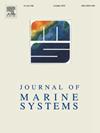Temporal scales of variability in Regions Of Freshwater Influence on the French continental shelf over two decades
IF 2.5
3区 地球科学
Q2 GEOSCIENCES, MULTIDISCIPLINARY
引用次数: 0
Abstract
The Regions Of Freshwater Influence (ROFIs) are defined as the area on the continental shelf in the vicinity of estuaries, where freshwater from the river significantly influence water properties and circulation. These regions are subject to a variety of dynamic forcings, including tides, winds and river runoffs, which exhibit considerable variability. The objective of this study is to identify the dominant time scales of variability of the three major ROFIs (Seine, Loire, and Gironde) of the French continental shelf and their evolution over the last two decades. In order to address these questions, we developed a high-resolution numerical simulation of the physical dynamics of the Bay of Biscay and the English Channel. The results demonstrate that the three ROFIs oscillate on the same two cycles: the semidiurnal cycle, caused by tides, and the annual cycle, linked to the seasonal variation in runoff. At the weekly and monthly time scales, two contrasting dynamics emerge. The Seine ROFI, situated in the eastern English Channel, is predominantly influenced by tides and exhibits a third oscillatory cycle, namely the fortnightly cycle. In the Bay of Biscay, the Loire and Gironde ROFIs are more influenced by wind events that shape their monthly variations. The interannual variations are primarily driven by runoff, with an observed reduction in ROFIs extension over the twenty years simulated correlated with a decrease in runoff. However, the combination of shorter timescale events impacts the interannual variability, leading to years with distinctive dynamics of the ROFIs.
20年来法国大陆架淡水影响区变率的时间尺度
淡水影响区域(rofi)被定义为河口附近大陆架上的区域,在那里,来自河流的淡水对水的性质和循环产生重大影响。这些地区受到各种动力强迫的影响,包括潮汐、风和河流径流,这些强迫表现出相当大的变异性。本研究的目的是确定法国大陆架三个主要rofi(塞纳河、卢瓦尔河和吉伦特河)的主要变率时间尺度及其在过去20年的演变。为了解决这些问题,我们开发了比斯开湾和英吉利海峡物理动力学的高分辨率数值模拟。结果表明,三个rofi在相同的两个周期上振荡:由潮汐引起的半日周期和与径流季节变化有关的年周期。在每周和每月的时间尺度上,出现了两种截然不同的动态。塞纳河ROFI位于英吉利海峡东部,主要受潮汐影响,并表现出第三个振荡周期,即两周周期。在比斯开湾,卢瓦尔河和吉伦特河的rofi更受风事件的影响,风事件决定了它们的月变化。年际变化主要是由径流驱动的,在模拟的二十年中观测到的rofi扩展的减少与径流的减少相关。然而,较短时间尺度事件的组合影响年际变率,导致具有独特动态rofi的年份。
本文章由计算机程序翻译,如有差异,请以英文原文为准。
求助全文
约1分钟内获得全文
求助全文
来源期刊

Journal of Marine Systems
地学-地球科学综合
CiteScore
6.20
自引率
3.60%
发文量
81
审稿时长
6 months
期刊介绍:
The Journal of Marine Systems provides a medium for interdisciplinary exchange between physical, chemical and biological oceanographers and marine geologists. The journal welcomes original research papers and review articles. Preference will be given to interdisciplinary approaches to marine systems.
 求助内容:
求助内容: 应助结果提醒方式:
应助结果提醒方式:


